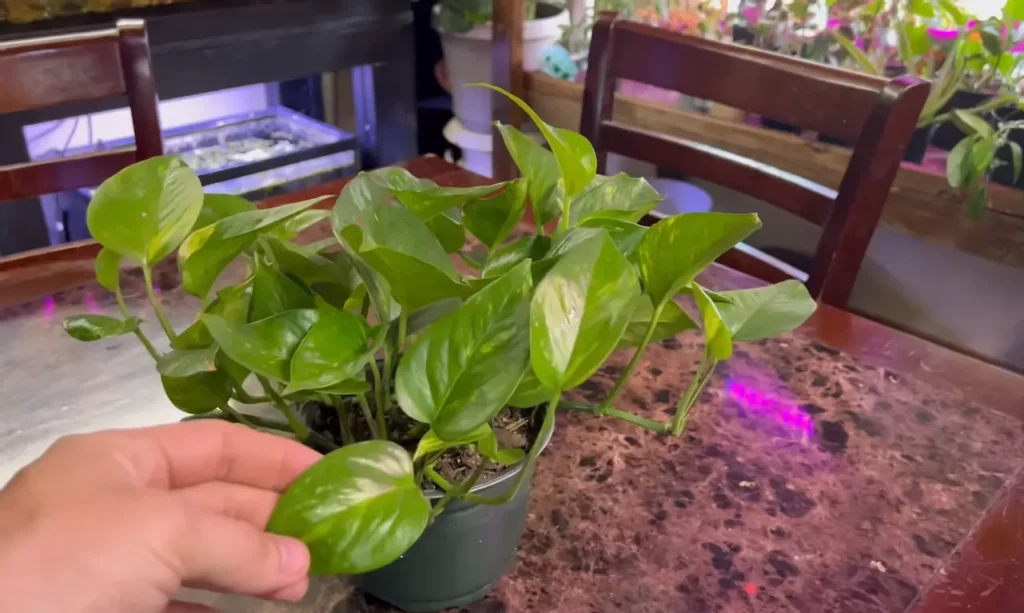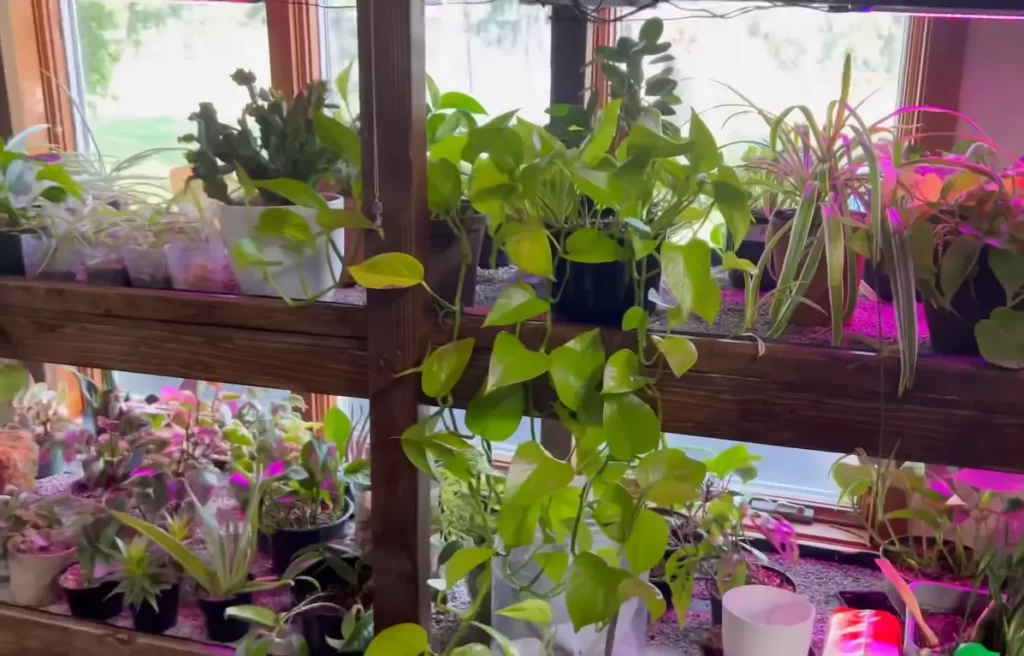Should I Mist My Pothos? Advice No One Will Give You
If you’re a plant enthusiast, chances are you’ve heard of the pothos plant. It’s a common and beloved houseplant known for its attractive trailing vines and easy-care nature.
Proper care is crucial for any plant’s growth and overall health. One question many pothos owners have is: Should I mist my pothos?
Yes, it is beneficial to mist your pothos, as it helps to keep the leaves hydrated and will boost humidity levels in the air. This is especially helpful during the winter months when the air is dry.
In this blog, we’ll explore the pros and cons of misting pothos and provide tips for caring for this popular plant.
Different Varieties of Pothos
Pothos is an excellent choice for people new to plant parenting, as it is easy to care for and has a high tolerance for neglect.

There are different varieties of pothos, each with unique characteristics.
Golden Pothos
Golden pothos is one of the most popular varieties of pothos. It has green and gold variegated leaves that stand out from other plants. Golden pothos is known for its air-purifying properties and is an excellent choice for indoor environments with insufficient air circulation.
Marble Queen Pothos
Marble queen pothos is a beautiful variety of white and green variegated leaves. It requires moderate to bright light and should be watered once a week. Marble queen pothos is susceptible to root rot and should be planted in well-draining soil.
Neon Pothos
Neon pothos is a unique variety of pothos that has bright neon-green leaves. It requires bright, indirect light and should be watered when the top inch of soil is dry. Neon pothos is an excellent choice for indoor environments with low to medium light conditions.
Jade Pothos
Jade pothos is a low-maintenance variety with solid green leaves. It can thrive in low-light conditions and should be watered once a week. Jade pothos is an excellent choice for people who want a plant that requires minimal care.
Snow Queen Pothos
Snow queen pothos is a variety of white and green variegated leaves. It requires bright, indirect light and should be watered when the top inch of soil is dry. Snow queen pothos is susceptible to spider mites and should be inspected regularly.
Should I Mist My Pothos?
Pothos plants are tropical plants that thrive in environments with high humidity levels. While they don’t necessarily require misting, it can benefit their growth and health, especially in dry indoor environments.
Misting can help increase the moisture level around the plant and keep the leaves looking lush and green. However, over-misting can lead to excessive moisture and root rot, so it’s important to balance the watering and misting. In general, misting once a week or every other week should be sufficient.
Alternatively, place a pebble tray filled with water under the plant to increase humidity levels. Be sure to provide adequate indirect light and avoid exposing the plant to direct sunlight, or spider mites may become a problem.
Benefits of Misting Pothos
One of the best ways to maintain the health of Pothos plants is by misting them regularly. Misting is a process of spraying water droplets onto the plant leaves to increase humidity levels. Here, we will discuss the benefits of misting Pothos plants.
Increases Humidity
Pothos plants are tropical plants and require a high level of humidity to thrive. Misting provides additional moisture to the leaves and creates a humid microenvironment around the plant. This is especially beneficial in dry environments or during the winter when the air can dry due to indoor heating.
Promotes Growth
Misting also promotes the growth of Pothos plants. The additional moisture and humidity help the plant absorb nutrients better, leading to faster growth. Mist the plants at least once a week for optimal growth.
Prevents Leaf Damage
Pothos plants can be sensitive to dry air and direct sunlight, which can cause the leaves to become dry, brown, and crispy. Misting helps to prevent leaf damage by increasing humidity levels and providing a protective layer of moisture on the leaves.
Deters Pests
Misting can also help to deter pests, such as spider mites, from infesting Pothos plants. Spider mites thrive in dry conditions and can cause significant damage to the leaves. Misting the plants regularly keeps the environment humid, making it less hospitable for pests.
Prevents Root Rot
Over-watering can lead to root rot in Pothos plants, which can be fatal. Misting provides the leaves with controlled moisture without soaking the soil, reducing the risk of root rot.
Risks of Misting Pothos
One common practice for caring for Pothos plants is misting them with water, but there are potential risks to be aware of.
Root Rot and Moisture Levels
Pothos plants prefer moist soil, but overwatering or misting too frequently can lead to root rot. This occurs when the roots are constantly wet and can’t access enough oxygen, causing them to decay. Misting Pothos plants too frequently can also increase the moisture levels in the air, which can contribute to the growth of mold and mildew.
Leaf Damage and Pests
Misting Pothos plants can also damage their leaves, particularly if the water droplets sit on the leaves for too long. This can create a breeding ground for pests, such as spider mites, which thrive in humid environments. These pests can cause damage to the leaves and slow the plant’s growth.
Light and Temperatures
Another risk to consider is the effect of misting on the plant’s exposure to light and temperatures. Misting the plant can reduce the amount of indirect light that reaches the leaves, slowing the plant’s growth.
Also, misting Pothos plants in cooler temperatures can lead to water droplets sitting on the leaves for too long, which can cause damage.
Alternative Methods for Humidity Control for Indoor Plants
Maintaining the right humidity level can be challenging, especially during winter. Here are some alternative methods to help increase the humidity for your houseplants.

Pebble Tray
A pebble tray is an easy and effective way to add moisture to the air around your indoor plants. Fill a shallow tray with small pebbles and add water until the pebbles are partially submerged.
Place your potted plant on top of the pebbles, making sure the water level does not reach the bottom of the pot. As the water evaporates, it will increase the humidity around the plant.
Misting
Misting your houseplants is another easy way to increase humidity levels. Fill a spray bottle with water and mist the leaves of your plants regularly. This method works best for plants that require moderate to high humidity levels, such as tropical plants.
Humidifier
A humidifier is an excellent option for those with many indoor plants or live in dry environments. It can provide consistent and long-lasting humidity levels. Set the humidifier near your plants and adjust the humidity levels as needed.
Grouping Plants Together
Grouping plants can create a microclimate with higher humidity levels. Plants release moisture through transpiration, and when grouped, they can increase the surrounding humidity.
Final Words
So, should I mist your pothos? The answer is yes! Misting the plant helps to keep the leaves hydrated and glossy and can also help to boost the humidity of your home.
Misting should be done regularly, but not too frequently, and ensuring that the water is at room temperature is important.
In addition, you should ensure the plant is well-rested as this can lead to rot and other problems. With regular misting, your pothos should be happy and healthy.
